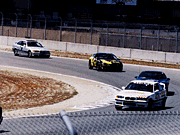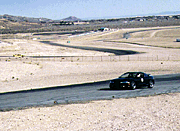Article Topics:
- Overview
- Intro to Racing
- Driving Technique
- Practice Sessions
- Driver’s Gear
- Vehicle Safety
- Handling
- Brakes
- Power
- Tools
TurnFast
recommends
these books:
Articles for Getting Started in Racing
Types of Club Racing
For the hobbyist or amateur auto racer, there's several ways to get on a track. Which method suits you best, depends on the type of racing you're interested in, and how much money you want to spend.
There is, of course, full-tilt amateur racing. You own or rent a fully prepared race car in one of numerous classifications, and you race with others for position. There are several organizations for this, the largest of which are SCCA and NASA for paved-surface road racing. This is the most time and money consuming method, but it is real racing.
There are also ways to use a daily driver car, and minimize the costs for more casual, but still exciting, high-speed, race-course driving events. This will minimize the level of competition you experience, but for many that's an acceptable compromise. Your main choices include hot lapping, time trialing, and autocrossing. These forms of racing are the focus of this web site.
Hot Lapping
Hot lapping is simply getting out on a race track and driving. More or less, it's a practice session. There's no battles for position, no recording of performance. You just drive. Typically, groups of cars are on the track at the same time, but it is strictly non-competitive with no contact and no passing in corners. You'll drive for 15 to 30 minutes at a time, and several groups rotate throughout the day or weekend. This type of driving is typically available through locally organized car clubs.
Even though the main purpose is not competitively oriented, many clubs will record lap times so you can measure whether or not you're improving. Cars may be classified for different levels of performance potential so you're on the track with similarly capable cars and drivers. However, with no specific rules about car modifications, there's really no meaningful competition as the cars may have significantly different potential to start with.
Time Trialing
Time trialing is organized as a competitive event where lap time, not wheel to wheel position is the measurement of the performance. Similarly capable cars are classified together. There may be very strict rules about the car and its modifications, or you might find a club that allows you to run whatever car you have (in which case the main point is the fun, not the competition).
Like hot lapping, there are typically practice sessions where several cars will be on the track at the same time. However, there will be a special session where only a few cars will be spaced out on the track for a two to five lap run. Each lap is timed, and the event is scored by fastest recorded lap times within each car classification.
Time trialing events are very similar to hot lapping events except for the formal timing during laps where the track is cleared so traffic is not a hindrance. It adds a little more competitive nature to the event which adds to the fun for most people.
Autocrossing
Autocrossing is a unique style of racing. The purpose is to provide a low speed event without the potential for collision, yet with the potential for a great deal of fun. Autocross courses are typically temporary courses marked off with rubber cones in large parking lots. The driver will have several timed runs through the course. Like time trialing, cars are classified in similar groups and scored according to the fastest times.
Autocross courses are much shorter, but have many more turns than a road course. This keeps the overall speed low, and the difficulty high--making for a challenging driving event. An autocross course is single pass. You drive the course only once straight through. You can think of it as a drag strip with turns. Because of these differences, there are several things in preparing for and driving in an autocross that are different than road course racing. We'll highlight these differences throughout the articles on the site.
Autocross racing is organized by local organizations, but also by the SCCA.
A word of caution about all of these events and your auto insurance. Whether formally or informally done, and regardless of the purpose (for scoring, or just for reference), if the club's or tack's officials are taking lap times, your auto insurance company will likely consider the event and your driving as "competition," and bump you into "not covered" territory. Any type of driving with the purpose of pushing the car's performance limits has risks, and both you and your car can suffer signficant and even fatal harm. You need to be certain what your auto and life insurance policies will and will not cover in the event of an accident.
Read Next Article (Trackside Preparation)
Tags: Car Clubs, Club Racing, Race Driving, Racing Schools, High performance Driving Schools

Hot lapping allows cars of all kinds from straight stock to retired race cars get out on the track for a high speed stretch of the connecting rods. Strict control of passing zones on straights keeps things safe.

Time trialing events are very similar to hot lapping. After several hot lapping practice sessions, a few cars are widely spaced on the track so each car can be timed for 2-3 unobstructed laps.
